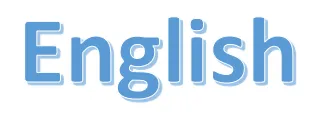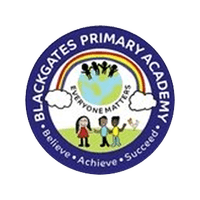
|
|
|
Reading and Writing and Phonics Lead: Julie Coulson
|
|
|
 |
Curriculum Intent
English
At Blackgates Primary Academy, we believe that a quality English curriculum should develop children’s love of reading, writing, speaking and listening. We aim to inspire an appreciation of our rich and varied literary heritage and a habit of reading widely and often for pleasure, as well as to inform. We recognise the importance of nurturing a culture where children take pride in their work, can write clearly and accurately and adapt their language and style for a range of contexts. We want to inspire children to be confident in the art of speaking and listening, to be able to use discussion to communicate and further their learning. We understand that for our children to gain and develop knowledge across the wider curriculum, they need to become competent readers. We have therefore created an interesting and relevant curriculum to teach them the knowledge and skills needed to prepare them for life-long learning.
Reading:
We want to motivate and inspire our children through offering a reading curriculum that promotes a true love of reading and enables pupils to be able to read competently, so that they can become confident and intelligent learners. We achieve this goal by teaching our youngest learners through a rigorous systematic, synthetic phonics programme, then by developing fluency, vocabulary and comprehension skills with Accelerated Reader in the older years. These reading programmes are accompanied by guided reading lessons that are planned carefully to suit the children’s interests and link to current topics, as well as directly teaching the skills of reading comprehension.
By the time children leave Blackgates Primary Academy, we aim for them to be competent readers who have a passion for literature and want to read to both inform and for pleasure. The children will have read a range of genres (including poetry and playscripts) and they will have participated in discussions, sharing their literary opinions and critiques about authors and language.
In the Early Years at Blackgates Primary Academy, phonics is taught through a highly structured programme of daily lessons across the Foundation Stage, providing a synthetic approach to the teaching of phonics. Each session gives an opportunity for children to revisit their previous experience, be taught new skills, practise together and apply what they have learned.
The teachers draw upon observations and continuous assessment to ensure children are stretched and challenged and to identify children who may need additional support. Children work through the different phases, learning and developing their phonics sounds and knowledge.
Children in Nursery begin with Phase 1 which provides a range of listening activities through play, to develop their listening skills. Progress is tracked at the end of each term. As children move into Reception they continue to build upon the listening activities and are introduced to Phase 2 which marks the start of systematic phonic work. Grapheme-phoneme correspondence is introduced. The process of segmenting whole words and selecting letters to represent those phonemes is taught, writing the letters to encode words. Phase 3 completes the teaching of the alphabet and then moves on to cover sounds represented by more than one letter, learning one representation for each of the 44 phonemes. At this stage just one grapheme (spelling) is given for each phoneme. When children become secure, they continue into Phase 4 where they start to read and spell words containing adjacent consonants. No new phonemes are introduced at this phase to consolidate their knowledge as they transition in to Key Stage One.
It is expected that children will enter Phase 5 as they begin Year 1, broadening their knowledge of graphemes and phonemes for use in reading and spelling. They will learn new graphemes and alternative pronunciations for these and graphemes they already know, where relevant. It is expected that children entering Year 2 will start Phase 6 which develops a variety of spelling strategies including homophones (word specific spellings) eg see/ sea, spelling of words with prefixes and suffixes, doubling and dropping letters where necessary. Also the accurate spelling of words containing unusual grapheme-phoneme correspondences eg laughs, two.
Throughout Key Stage One, we ensure that the children are building on knowledge and skills learned from the Early Years. We support pupils to sound out and blend unfamiliar words quickly and accurately to apply their phonics knowledge already learned. Phonics is taught daily in Year One and they learn new graphemes and alternative pronunciations for these and other graphemes they already know, where relevant.
By the end of Year One, we aim for children to have the knowledge and confidence in phonics to succeed in their phonics screening check. They are exposed to quality conversations with class teachers and support staff to begin practising early skills in reading comprehension to ensure children are understanding what is read. Story time within the Foundation Stage and Key Stage One is prominent in our school as we need to expose our children to lots of vocabulary and make them aware of the wider world through various fiction and non-fiction texts.
To ensure that the stages of early reading in our school are reinforced, our Reception and Key Stage One teachers provide children with a book that is suited to their learning in phonics. We use informed assessments each half term to track and monitor the children’s progress in reading. In addition, we send weekly reading books home to promote the love of reading. We display the current sounds and high frequency words through our inspiring and informative learning environments and children throughout school are encouraged to use them.
Whole class guided reading lessons are taught three times a week from Year 2 to 6. These sessions allow children to be taught the national curriculum objectives that have been organised appropriately to ensure progression (see progression of skills and knowledge in reading document). We use the Big 10 comprehension skills to support the reading objectives throughout the year which enable children to become competent readers and to develop skills in the following areas:
- The goal – To explore the purpose of the text.
- Preview – Looking at the features of texts.
- Monitor – To monitor that you understand what you are reading.
- Visualise – To train readers to visualise what they are reading.
- Connect – To relate the text to your own thoughts and feelings.
- Question – To ask who, what, when, where questions linking to texts.
- Infer – To think about what the details are telling you.
- Predict – To use evidence to build predictions of what will happen next.
- Summarise – To identify and discuss central themes and topics.
- Evaluate – To think about what you have learned and create thoughts and opinions linked to texts.
In addition to guided reading sessions, children practise their comprehension skills further completing a RIC. Either a photo, diagram, front cover or an extract from a text is given to pupils answer questions that use retrieval, inference and choice skills. We use this activity across the curriculum and teachers tailor their RICs to suit the current topic being covered in class. This provides further opportunity for children to access vocabulary and develop their knowledge and around their topic.
To create competent and passionate readers in our school, we use the extremely successful Accelerated Reader programme. The scheme allows children to be given a ‘Zone of Proximal Development’ in reading and a reading age. Children can then access books and texts that are pitched at their level, and their comprehension and understanding is tested through an online quiz. The data acquired from the children’s tests and quizzes has proved invaluable to our staff, particularly our Year 6 teachers. From this data, Upper Key Stage Two teachers can correlate the Accelerated Reader scaled score children who are on track to meet the expected standard and greater depth in the end of year assessment. The data can also be used to compare the ability of children in our school to those nationally when analysing the children’s reading scores.
Using Accelerated Reader has allowed our children to choose real books rather than reading scheme books and read a wide variety of fiction and non-fiction. This programme inspires our children to read and improve their comprehension skills in an interactive and exciting way. Teachers also introduce class rewards and motivators to build healthy competition amongst one another to score highly on quizzes.
Blackgates Primary Academy offers a library for children to borrow books from to take home and each classroom has a reading area with inspiring learning environments to allow children to have the resources and opportunity to read for pleasure. Throughout Key Stage Two we have whole sets of class novels to encourage children to read and appreciate texts they wouldn’t normally choose. To encourage reading outside of the classroom, we hold whole school reading competitions regularly and celebrate the anniversaries of famous authors. Teachers also model their love of reading to the children to ensure we, as staff, are setting high expectations and modelling good reading learning.
If children are working behind the expected level in their reading, interventions and additional support is put into place quickly. We ensure parents are informed and given resources to support them at home too and to try and close the gap.
Many of our children in our school lack a wide range of vocabulary and some have had very minimal life experiences. We understand our vital role in preparing children for the wider world and aim to teach them about life outside of Tingley through many different genres and texts to create a passion for reading amongst our children.
Writing:
In EYFS children are exposed to a wide-range of mark making activities and provision choices that support writing and the development of fine and gross motor skills. They begin to learn phonic sounds and develop their sound discrimination. They listen to stories to develop patterns of language and sentence structures they can use in their own writing or oral story telling. They begin by writing phonemes, then words and eventually sentences to retell stories and write labels and captions using the letter formation they have been taught and practised.
The Write Stuff Approach by Jane Considine is used across school and begins in Early Years. This approach focuses heavily on vocabulary development, sentence structure and understanding the features of text types. This process begins orally in the Foundation Stage, with the teacher modelling first the spoken then written language, until children are ready to write for themselves.
In KS1, English is linked to the six whole-school topic areas. Children are exposed to high-quality texts and real-life experiences to support their development in reading, writing and spoken language. Key texts are allocated to year groups to ensure that children are being immersed in high-quality writing examples by a range of quality authors. Year 1 build on the foundations of The Write Stuff approach from Reception and this continues further in Year 2.
In KS1, children build on their phonic knowledge from Foundation Stage and learn different graphemes to represent the phonemes they already know. They extend their knowledge of how to read and spell common exception words and begin to learn rules for common prefixes and suffixes. Children are introduced to homophones and apostrophes for contractions and possession. Year 2 begin to use the Spelling Shed to structure their teaching of spellings. In KS1, children are taught to create sentences that are punctuated accurately in either the simple past or present tense. Children are taught to extend their sentences using subordination and coordination in order to add detail to their initial ideas. They begin to learn basic grammatical terminology and this is built on in KS2 as sentence structures become more complex.
Children are also taught a range of genres which focus on the purposes of writing to inform and writing to entertain. They write about both real events, which is supported by real-life experiences, and fictional events, supported by high-quality texts. Cross-curricular links are made with the six whole-school topics so that children connect different areas of learning together.
In Years 3 and 4, teachers continue to use Spelling Shed to extend children’s knowledge of spelling rules. High-quality texts are used as a stimulus for writing and children are taught to discuss the writing and use the content, structure and grammar as ideas for their own work. They build on the expanded noun phrases learned in KS1 and become more confident at creating characters, setting and plot. They develop their sentence structures by using conjunctions and fronted adverbials and are taught a wider range of punctuation. Again, a clear whole-school plan of genre coverage ensures that children are given a variety of writing opportunities and taught the features of a variety of text types. Their ability to write to inform and write to entertain is developed from KS1 and they are also taught devices to help them write to persuade.
In years 5 & 6, children are taught to consider their audience and purpose carefully and to make choices about their writing. Key texts are allocated to year groups to ensure that children are being immersed in high-quality writing examples by a range of quality authors. In addition to the key grammatical content from the National Curriculum, we also want our children to be able to develop as creative writers which means teaching children to assess the effectiveness of writing as they propose changes. For this to happen, it is important that children understand the full range of grammatical terminology for KS2. Giving children time to edit their own work is vital and children become increasingly independent at this. Advanced sentence structures with multiple clauses are taught alongside the full range of KS2 punctuation. In Upper Key Stage 2, children write in a range of genres and are able to write to inform, entertain, persuade and discuss. They are able to use writing as a way of communicating their ideas and knowledge about other areas of the curriculum.
Throughout school, Jane Considine’s The Write Stuff help scaffold children’s writing and teach them about sentence structure, central character writing and features of different genres. The FANASTICS are used to structure children’s ideas and BOOMTASTICS and GRAMMARISTICS are used to support children in using literary devices and aspects of grammar to enhance their writing. We focus on the language authors use and the way that sentences are structured, thinking about how they impact on the reader.
Modelling is used throughout school to support planning and writing and teachers plan these models carefully in advance of the lesson in order to ensure the model includes the teaching points from the unit.
Throughout the school, the Letter Join Handwriting Scheme is used. This supports children to develop the correct letter formation and accurate joining of handwriting. By the end of KS2, we want children to be able to write fluently and at speed, so that they can communicate through their writing.
A lot of our children enter school with extremely limited vocabulary knowledge and so it is important that we support children’s vocabulary development. We do this throughout the curriculum in addition to the strong focus we place on vocabulary development through our daily writing lessons.



















